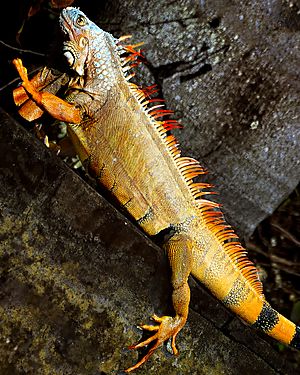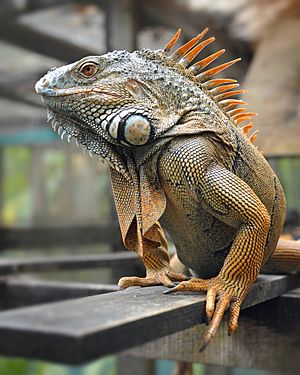Iguana facts for kids
Quick facts for kids IguanaTemporal range: Holocene - Recent
|
|
|---|---|
 |
|
| A green iguana (Iguana iguana) | |
| Scientific classification |
|
| Kingdom: | Animalia |
| Phylum: | Chordata |
| Class: | Reptilia |
| Order: | Squamata |
| Suborder: | Iguania |
| Family: | Iguanidae |
| Genus: | Iguana Laurenti, 1768 |
| Type species | |
| Iguana iguana Linnaeus, 1758
|
|
| Species | |
|
|
| Synonyms | |
|
|

Iguana is a type of lizard that lives in tropical areas of Central and South America and the Caribbean. There are only two species of Iguana: the Green Iguana and the Lesser Antillean Iguana
The word "iguana" is derived from the original Taino name for the species, iwana. Iguanas are often kept as pets.
Iguanas are often hard to spot, as they blend into their surroundings, and their coloration helps them to hide from predators.
Contents
Appearance
The two species of lizard both have a dewlap, a row of spines running down their back to their tail, and a third eye on their head. This eye is known as the parietal eye, which looks just like a pale scale on the top of their head. Behind their neck are small scales which look like spikes, and are called tuberculate scales. They also have a large round scale on their cheek called a subtympanic shield.
Senses
Iguanas have excellent vision and can see long distances, shapes, shadows, color and movement. An iguana uses its eyes to navigate through trees and forests, as well as for finding food. They also use their eyes to communicate with members of the same species. An iguana's ear is called a tympanum. It is the iguana's ear drum and is found right above the subtympanic shield and behind the eye. This is a very thin, delicate part of the iguana, and is very important to its hearing.
Diet

Iguanas have developed a herbivorou lifestyle, foraging exclusively on vegetation and foliage. In order to acquire, process, and digest plant matter, herbivorous lizards must have a higher bite force relative to their size. The skull of the iguana has undergone modifications resulting in a strong bite force and efficient processing of vegetation, according to one study.
In order to accomplish this biomechanically, herbivorous lizards (such as the iguana) have taller and wider skulls, shorter snouts, and larger bodies relative to carnivorous and omnivorous reptiles.
The teeth of the Green Iguana sit on the surface of the jawbone, known as acrodontal placement. Furthermore, the teeth of the iguana are acrodontal, meaning that their teeth sit on top of the surface of the jaw bone and project upwards. The teeth themselves are small and serrated - designed to grasp and shear food.
As food
Iguanas have historically featured in the culinary traditions of Mexico and Central America. Iguana meat is also consumed in parts of the United States and Puerto Rico. Also, the eggs of iguana are consumed in some parts of Latin America, such as Nicaragua and Colombia.
Images for kids
-
A male green iguana
-
Green iguana skull and teeth: The teeth of the green iguana sit on the surface of the jawbone, known as acrodontal placement.
See also
 In Spanish: Iguanas verdaderas para niños
In Spanish: Iguanas verdaderas para niños



